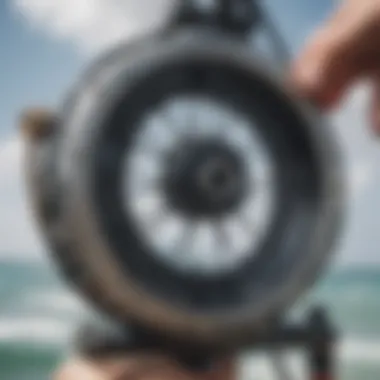Understanding Liquid Force Kite Pumps: A Complete Guide


Intro
Kiteboarding is not just a sport; it’s an exhilarating way to connect with the water and the wind. However, one pivotal element that can make or break your experience is the kite pump you choose. Liquid Force kite pumps boast advanced design and functionality that can significantly enhance your time on the kiteboarding field. Understanding the components and the mechanics involved with these pumps is crucial for both novices and seasoned kiteboarders alike.
In this guide, we delve into the various intricacies of Liquid Force kite pumps, from their essential parts and designs to the types that cater to different user needs. This exploration aims to equip you with the knowledge necessary for selecting the right pump and maintaining it to ensure lasting performance. Let’s begin by stepping into the realm of gear insights.
Preamble to Kite Pumping
Kite pumping is an essential component for any kiteboarding enthusiast. It’s not just a task to check off your pre-ride list but a vital part of the overall experience. Understanding the nuances of how to properly inflate your kite can lead to improved performance on the water. There’s a delicate balance between ensuring your kite has the right amount of air and preserving its longevity. Over-inflating can harm your kite just as much as under-inflating can. Thus, knowing the mechanisms at play in kite pumping is crucial.
In this section, we will explore the significance of kite pumping, its history, and why getting it right matters. By grasping these elements, kiteboarders can maximize their time on the water, leading to a more enjoyable experience.
The Evolution of Kite Pumps
The journey of kite pumps is fascinating. Early kite pumps were fairly basic, often resembling the hand pumps used for sports balls. As interest in kiteboarding grew, so too did the technology surrounding the sport.
Modern Liquid Force kite pumps have seen a marked improvement over time. Initially, most pumps were limited to single-action designs. This means a single stroke drew air only on the upstroke or downstroke, which had its limitations in efficiency. Today’s models, however, typically use a double-action mechanism allowing air to flow in both directions, effectively cutting the time needed to inflate a kite in half. The result is less downtime and more time for riding, which is what every kiteboarder craves.
Liquid Force, a name synonymous with advancement in watersports, continually innovates, incorporating materials that are not only lightweight but ensure durability.
Why Kite Pumps Are Essential
The importance of having a quality kite pump cannot be overstated. Beyond just inflating, it sets the foundation for the kite's performance. If your kite is not adequately inflated, it may perform poorly or even flop in the air. There are several reasons why choosing the right pump is essential:
- Efficiency: A good pump will get your kite fully inflated quicker, meaning you can hit the water faster.
- Performance: Proper inflation leads to a more responsive kite, allowing for better control and maneuverability.
- Longevity: Regular and careful maintenance of your pump leads to a more extended lifespan for both the pump and the kite.
"A well-pumped kite is your ally on the water; underestimating its importance can lead to heartbreak on the waves."
Understanding kite pumping isn’t just about technical aspects but also entails knowing how your choices impact your experience. Choosing the right pump and technique can enhance your overall kiteboarding adventure.
Liquid Force Kite Pumps Overview
Understanding Liquid Force kite pumps is crucial for anyone keen on making the most of their kiteboarding adventures. These pumps are not just tools; they play a significant role in ensuring your kite stays inflated, thereby enhancing your overall experience on the water. A reliable pump can mean the difference between a day filled with exhilarating rides and one spent wrestling with a deflated kite.
Liquid Force has carved a niche for itself in the kiteboarding community, and knowing the ins and outs of what they offer can be invaluable to kiteboarders of all skill levels. This section delves into the company’s rich history and innovations, as well as the standout features that make their pumps worthy of consideration.
Brand History and Innovation
Established in 1996, Liquid Force started with a mission to innovate and inspire the sport of kiteboarding and wakeboarding. The brand gained a reputation for pushing the envelope in design and technology, consistently offering products that align with the evolving needs of its users. This commitment to advancement is evident in their kite pumps, where functionality meets user-centered design seamlessly.
For instance, one of their significant milestones was the introduction of the high-volume pump, which drastically reduced pump times for kiteboarders. Unlike older models, these pumps allow users to inflate their kites quickly and efficiently, leaving more time to enjoy the water. Liquid Force continually integrates customer feedback into their design process, resulting in pumps that cater to a wide array of preferences and pumping styles.
Key Features of Liquid Force Pumps
When selecting a kite pump, understanding the features can greatly influence your choice. Liquid Force pumps stand out due to several key aspects that enhance usability and performance:
- Durable Materials: Built from high-quality, weather-resistant materials, Liquid Force pumps are designed to withstand the rigors of outdoor use.
- Ergonomic Design: The handles and grips are engineered for comfort, making pumping easier on the hands. This is not just a matter of luxury; having an ergonomic pump means you can inflate your kite with less effort, especially after a long day on the water.
- Air Pressure Capabilities: With innovative air pressure dynamics, these pumps can achieve optimal inflation with less effort, meaning that you’ll have more time to ride and less time squeezing the pump.
- Multiple Valve Compatibility: Featuring various nozzle attachments, Liquid Force pumps work with different kite brands and models, adding versatility to your gear. No one wants to be caught on the beach with a pump that doesn't fit.
"A reliable pump is the lifeblood of any kiteboarding session; you wouldn't hit the waves without one."
Understanding these features can help potential buyers make informed decisions, ensuring they choose a pump that suits their unique needs. As kiteboarding continues to grow in popularity, equipping yourself with a Liquid Force pump could certainly up your game, enabling smoother launches and maximizing your time on the water.
In the following sections, we will explore the mechanics of kite pumping in detail, diving into how air pressure operates within the pump, optimal techniques for effective inflation, and the various types of Liquid Force pumps available. The goal is to build an informed, practical approach to kite pumping—so stay tuned!
Mechanics of Kite Pumping
When it comes to kiteboarding, the actual act of pumping your kite may seem straightforward, but there are quite a few dynamics at play that can significantly affect performance. By grasping the mechanics of kite pumping, not only do you become familiar with how to efficiently fill your kite with air, but you also understand the implications this has on your overall kiteboarding experience. Taking time to learn the intricacies could mean the difference between an exhilarating ride and a frustrating day out on the water.
Understanding Air Pressure Dynamics
One of the most crucial concepts in kite pumping is air pressure. It governs how much air you can get into your kite, affecting its ability to lift and perform.
Air pressure is essentially the force exerted by the weight of the air molecules around us. As you pump your kite, you are compressing air into the bladder of the kite, allowing it to maintain its shape and effectively catch the wind. The trick here is to achieve the right pressure—too little, and your kite may not inflate properly; too much, and you risk damaging your kite or reducing its performance due to overly stiff fabric.


Technical aspects to consider include:
- Barometric Pressure: Changes in altitude and weather significantly impact air pressure levels. Pumping in different conditions calls for quick adjustment.
- Temperature Influence: Warmer air expands, while cooler air contracts. Know when to pump based on the environment to ensure your kite gets the appropriate amount of air.
- Pump Efficiency: Designs differ among pumps, affecting how easily air is pushed into the kite. A pump that maximizes air flow reduces the time spent inflating, leaving you more time to enjoy your ride.
Understanding these factors can help kiteboarders make educated choices when selecting their gear and timing their adventures.
Optimal Pumping Techniques
Using the kite pump effectively is an art in itself. Knowing how to apply the right techniques can save you sweat and time, while also ensuring that your kite is optimally inflated.
- Two-Handed Method: Employing both hands allows you to generate more force. Switch your grip from one handle to the other at intervals to prevent fatigue and keep the pumping process smooth.
- Rhythm and Pace: Establishing a consistent rhythm can make pumping easier. A steady pace allows you to maintain momentum and ensures a fuller inflation cycle with each push.
- Watch the Gauge: Many pumps come with a pressure gauge. Aim for the recommended pressure for your kite, usually indicated in the user manual. Stop pumping once you reach this mark to avoid over-inflation.
- Practice Makes Perfect: The more familiar you become with your pump and kite, the easier it gets. Regular practice not only increases your efficiency but also helps you notice subtle cues about how well your kite is inflating.
- Keep Your Pump in Top Shape: Regular checks on the pump itself are necessary. Ensuring that valves are working and there are no leaks can make pumping smoother and more effective.
"Consistency in pumping techniques not only boosts your kite’s performance but makes the entire kiteboarding experience much more enjoyable."
Grasping the mechanisms of kite pumping, particularly air pressure dynamics and optimal techniques, can transform the kiteboarding experience from the ordinary to the extraordinary. It arms enthusiasts with the know-how to ensure that every adventure is thrilling and devoid of avoidable hassles.
Types of Liquid Force Kite Pumps
Understanding the breadth of options available when it comes to Liquid Force kite pumps is crucial for anyone serious about kiteboarding. Having the right pump tailored to your specific needs can greatly impact your experience on the water. Different types of pumps offer distinct benefits and functionalities, which can elevate or hinder your performance. Let’s explore these variations in detail, helping you make an informed choice.
Single Action vs. Double Action Pumps
Single action pumps are straightforward in their operation. They inflate the kite with air during the upward stroke only. This means every pump stroke only fills the kite with air once, making it a more natural and simple choice for beginners or those looking for a lightweight option. The simplicity, however, may lead to inefficiency, especially when trying to inflate larger kites quickly.
On the contrary, double action pumps push air into the kite on both the upward and downward strokes. This is akin to squeezing a sponge; you get more bang for your buck with each motion. The dual-action system allows for quicker inflation, which can be a game-changer when you’re racing against time or conditions changing. Keep in mind, double action pumps might feel a bit heavier and require more effort during use, particularly at higher pressures.
In summary:
- Single Action Pumps: Simpler, lighter, ideal for smaller kites or beginners.
- Double Action Pumps: Efficient, quicker inflation, but can be a workout.
Electric vs. Manual Pumps
The choice between electric and manual pumps often comes down to convenience versus control. Electric pumps are a godsend for many kiteboarders. With just the press of a button, you can fill your kite with air, saving energy and time. This can be especially advantageous when you're on the beach and conditions are changing, allowing you to get on the water quicker. However, reliance on a power source can be a double-edged sword; if you’re far from amenities or in remote locations, you might find yourself in a predicament.
On the flip side, manual pumps require more physical training but offer unparalleled control over the inflation process. You can feel the pressure build and adjust accordingly, which is crucial if you're prepping for a challenging session. Plus, they’re always ready to go without needing any power outlet. For those who frequently venture to off-the-grid locations, manual options become a reliable friend.
Here’s a quick comparison:
- Electric Pumps: Faster, automated, ideal for those wanting ease.
- Manual Pumps: Involves physical effort, greater user control.
Hybrid Options Available
As the title suggests, hybrid pumps combine features from both manual and electric designs. They often include a manual pumping feature within the electric system, allowing you to use electricity when available and revert to manual mode when necessary. These versatile tools cater to a range of conditions and preferences, appealing to kiteboarders who value flexibility in their gear.
Many hybrid models are equipped to handle different kite sizes and inflation pressures, usually containing user-friendly interfaces for adjusting settings. This adaptability might come with a heftier price tag than traditional models, but if you're a frequent kiteboarder, the investment could certainly pay off in convenience and performance.
Ultimately, when choosing a pump, consider not just your immediate needs but also future journeys and conditions.
"The right pump isn't just a tool, it’s an extension of your kiteboarding experience. Make sure you're equipped for success."
In summary, by understanding the specific types of Liquid Force kite pumps available and weighing their respective advantages, you can tailor your kiteboarding experience. Whether you’re inflating with ease through an electric command or opting for the hands-on control of a manual, the choice paves the way for your adventures on the water.
Choosing the Right Kite Pump
When kitesurfing, every detail matters, and this includes selecting the right kite pump. Choosing the right kite pump can significantly impact your experience on the water. A well-suited pump can save time, enhance efficiency, and ensure safety while pumping your kite. This section highlights the essential elements to consider, benefits, and what to weigh when deciding on the best kite pump for your specific needs.
Factors to Consider
There are a few factors you must take into account in selecting a pump. Here are the key points to focus on:
- Pump Type: Understand the difference between single action and double action pumps. Single action inflates on the upstroke, whereas double action pumps work during both up and down strokes. Depending on your pumping style and preference, this choice can save you time and effort.
- Material and Build Quality: It's imperative that your pump is made from durable materials. Look for pumps constructed from robust plastics or metal, which offer longevity, particularly in harsher conditions. A flimsy pump won't last long.
- Portability: Kiteboarding often means traveling. A pump that is too bulky can be a hassle. Opt for lightweight designs that can easily fit in your gear bag without adding excessive weight.
- Air Pressure Gauge: Some pumps come with built-in pressure gauges. This feature can be particularly helpful for ensuring your kite is properly inflated, enhancing safety and performance.
- Connection Compatibility: Ensure that the pump's nozzle fits well with your kite's inflation valve. A mismatch can lead to air leaks, ruining your session before it even starts.
Top Models and Recommendations
When it comes to choices, here are a few top-rated models known for their reliability and performance:


- Liquid Force Hi-Pressure Pump: Perfect for those needing efficiency and quick inflation. It has a sturdy build and is equipped with a pressure gauge allowing you to achieve optimal pressure.
- Sevileng Travel Pump: An excellent lightweight option, designed for easy packing. This one does not compromise on performance despite its size, making it a favorite among travelers.
- North Kiteboarding Pump: Known for its double-action capability, this model rapidly inflates your kite and features a compatibility with a variety of kite valves.
- Slingshot Pump: Offers a balance between portability and performance. Its durable construction ensures it can take the hits and still deliver when called upon.
In the end, the right kite pump is a blend of personal preference and specific requirements. Evaluating these factors and considering reputable models can greatly improve your kitesurfing experience. Just remember, a well-chosen pump isn’t just a tool; it can be a game changer on your next adventure.
"The right gear can make all the difference, especially when the wind is just right and every second counts."
Take your time to weigh your options and choose wisely; you won't regret it.
Maintenance and Care of Kite Pumps
Proper maintenance and care of your kite pump is often the unsung hero behind a kiteboarder's performance on the water. These pumps are not just tools but rather, vital companions to any kiteboarding adventure. When invested in with routine care, they tend to operate smoothly, enabling you to spend more time riding the waves rather than fixing equipment. This section explores the significance of regularly maintaining your Liquid Force kite pumps, equipping you with knowledge that can double the lifespan of your gear and keep downtime during sessions at bay.
Routine Check-ups
Just like any piece of equipment, your kite pump deserves a regular onceover. A routine check-up doesn’t have to be an elaborate process but should include a few key aspects:
- Visual Inspection: Check for any visible wear and tear such as cracks in the pump body or tears in the hose. Any small damage can escalate quickly if left unaddressed.
- Hose Connection: Make sure the attachment points and connectors are secure. If things are loose, air may escape, defeating the purpose of inflating your kite.
- Pressure Gauge Check: If your pump has a pressure gauge, ensure it reads accurately. An inaccurate gauge can lead to under-inflation or over-inflation, which can both hinder your performance.
By maintaining this simple checklist, you can catch small issues before they turn into larger repairs, ultimately saving you time and money.
Lubrication Tips
Lubrication is key to ensuring your kite pump functions well. Many enthusiasts overlook this step, thinking it’s not essential. But here’s the reality: properly lubricated moving parts can significantly extend the longevity of your pump. Here are some practical lubrication tips:
- Use the Right Lubricant: Always opt for non-corrosive, waterproof lubricants. Silicone-based greases work wonders and are least likely to interfere with the materials of your pump.
- Lubricate After Every Few Uses: It doesn’t take much lubrication to keep things running smoothly. Every few uses, wipe down the pump's moving parts with a bit of lubricant to keep them from getting stiff.
- Regularly Inspect Seals and O-rings: These parts often get neglected. A little grease on these components can prevent air leaks and ensure a tight seal.
Lubrication isn’t just about ease of use; it’s a fundamental part of your pump's health.
Storing Your Pump Correctly
How you store your pump can make or break its future performance. Proper storage practices are crucial not only for convenience but also for maintaining your gear’s integrity. Here are some best practices:
- Dry Before Storage: Moisture can cause mold or degradation of certain materials. Always ensure your pump is completely dry before putting it away.
- Avoid Sunlight: Direct exposure to the sun can damage the materials. When not in use, store your pump in a cool, shaded space.
- Use a Protective Case: If possible, keep your pump in a case or bag. This minimizes the chances of accidental damage during transit.
Proper care and maintenance significantly extend the lifespan of your Liquid Force kite pump, making every session smoother and more enjoyable.
Adhering to these maintenance and care practices will keep your Liquid Force kite pump in top shape, allowing you to concentrate on what truly matters—having a great time on the water.
Troubleshooting Common Pump Issues
When you’re on the water, the last thing you want is to deal with a malfunctioning pump. That’s why troubleshooting common pump issues is critical for kiteboarding enthusiasts. Understanding how to swiftly identify and rectify these issues can save time, money, and, more importantly, your enjoyment on the water. From air leaks to irregular performance patterns, knowing the signs and solutions allows you to keep your kite pump in tip-top shape.
Dealing with Air Leaks
Air leaks are a frustrating yet common predicament that can severely impact the efficiency of your kite pump. If you're getting less air pressure than expected, pay close attention. Leaks often stem from worn-out seals, punctured hoses, or loose connections.
To diagnose an air leak:
- Visual Inspection: Look closely for any visible cracks or wear on the hose and connectors. If there’s a break or a poorly sealed area, you’re likely losing air.
- Feel for Air: While the pump is in use, run your hand along the hose and connections. If you feel air escaping, you've found your leak.
To fix this:
- Seal Repairs: For small cracks, consider using silicone sealant. A quick application can sometimes rectify the issue effectively.
- Replace Seals: If the leak is from a seal, replacing it might be the best option. Make sure to get seals that are compatible with Liquid Force pumps.
Fixing air leaks not only means more air pressure but also ensures that your sessions go smooth.
Maintaining Optimal Performance
It's important to keep your pump running optimally to enhance your kiteboarding experience. Over time, sediment, and debris can build up, making the pump less efficient. Achieving peak performance involves a few, straightforward care routines.
Here’s how you can ensure that your pump stays in its best form:
- Regular Cleaning: After each use or at least once a month, open up the pump to clean out the internal mechanisms. Sand and saltwater can wreak havoc on its components. Use a soft brush to dust off any debris.
- Check and Inflate: Inspect the pump's inflation mechanism. Make sure it’s not clogged. A quick test inflating a deflated kite can reveal if something seems off.
- Store Properly: When the session is over, let the pump dry out before storing. Moist places can lead to mold or even corrosion in the long term.


Tip: Keeping a log of your pump’s maintenance can help you track its performance over the years.
By recognizing issues like air leaks and maintaining optimal performance, kiteboarders can extend the life of their Liquid Force pumps, ensuring many more windy days ahead.
Safety Considerations During Pumping
When engaging in kite pumping, it’s easy to get lost in the excitement of preparing for a session on the water. However, safety must take center stage. The act of pumping a kite requires not only physical effort but also awareness of potential risks. Neglecting safety measures can lead to not only injury but also compromise your overall kiteboarding experience. This section underscores critical safety elements to keep in mind during the pumping process.
Protective Gear and Precautions
Using the right protective gear while pumping your kite can make a world of difference. Though it might seem overkill for a simple task, kite pumping can pose certain hazards. Wearing appropriate gear helps mitigate those risks. Here’s a closer look at the essentials:
- Gloves: Protects your hands from blisters and cuts. The rubber grips on some pumps can be unforgiving, especially during longer pumping sessions.
- Sturdy Footwear: Sandals might be comfortable, but they can leave your feet exposed to injuries from gear or loose equipment.
- Kite Safety Leash: Depending on your setup, having a safety leash ensures your kite doesn’t escape unexpectedly, which could lead to damage or injury.
Taking these precautions not only enhances safety but also fosters a more focused and enjoyable kite pumping experience.
Environmental Factors to Keep in Mind
The surrounding environment plays a significant role in kite pumping safety. Variability like weather conditions and terrain can impact how effectively – and safely – you pump your kite. Here are some notable considerations:
- Wind Conditions: Always check the wind speed before you begin pumping. High winds can easily catch the kite, turning it into a flying projectile. Stay grounded, literally and figuratively.
- Space and Terrain: Make sure you have adequate space around you. Avoid crowded areas where other riders are rigging their gear. Likewise, be mindful of uneven terrain that could result in trip hazards.
- Obstructions: Look out for nearby objects such as rocks, trees, and other kites that might hinder your movement or create potential risks while pumping.
Keeping these environmental elements in check not only promotes personal safety but also respects the space of other kiteboarders around you.
"A safe setup makes for a smooth day on the water. Don’t cut corners with safety."
By being proactive about safety during your pumping routine, you position yourself to enjoy a worry-free kiteboarding experience. Remember, a little preparation goes a long way!
The Future of Kite Pumps
The future of kite pumps is not just about making things easier for kiteboarders; it’s about innovation driving performance and sustainability in a sport that relies heavily on the natural environment. With advancements in technology and a growing awareness of environmental issues, the next generation of kite pumps aims to address the dual concerns of efficiency and ecological impact. As kiteboarding enthusiasts seek out gear that enhances their experience, understanding these developments is crucial for making informed decisions.
Emerging Technologies in Pump Design
In the realm of kite pump design, tech-savvy innovations are unfolding at a rapid pace. Companies are now integrating smart technology into their pumps, enabling real-time monitoring of air pressure and even temperature. Imagine a pump that can communicate with your smartphone, alerting you about optimal pressure levels for your particular kite. This integration not only simplifies the pumping process but also helps enhance kite performance, ensuring that the kite is aligned for ideal aerodynamic conditions.
Another innovation gaining traction includes lightweight materials like carbon fiber and advanced polymer blends. These materials not only reduce the pump's overall weight but also provide superior durability against harsh weather conditions. The shift towards lighter pumps means kiteboarders can travel with less hassle, not needing to drag heavy equipment to their next adventure.
Moreover, ergonomics is taking center stage in pump design. Handles and grips are being studied scientifically to ensure comfort and reduce fatigue during prolonged use. The latest models feature adjustable grips and streamlined pumping systems that require less effort to operate, helping enthusiasts to pump up quicker and get to the water faster.
"A lighter, smarter pump fundamentally reshapes the kiteboarding experience—embracing innovation while respecting the thrill of the waves."
These new technologies promise to make inflating a kite not just a task to get done but a seamless part of the excitement of preparing for the ride.
Sustainable Practices in Production
As kiteboarding evolves, it is becoming more necessary to incorporate sustainable practices into the production of kite pumps. With a significant portion of kiteboarding gear previously made from non-biodegradable materials, the push for eco-friendly options is essential for the health of our waters and beaches. Many manufacturers are now sourcing recycled materials or investing in bio-based alternatives. This shift reflects a broader commitment across adventure sports to protect the environments athletes enjoy.
Sustainable design is also introducing recyclable packaging and renewable materials to reduce waste during shipping and production. A kite pump that lasts longer and is produced responsibly reduces both financial and environmental costs over time.
In addition, companies are increasingly taking a comprehensive approach to their supply chains. This includes minimizing carbon footprints through strategic logistics and endorsing fair labor practices. The transparency about these practices is crucial for consumers who value the ethos of the brands they support.
The journey towards greener kite pumps highlights the potential to harmonize adventure sports with environmental stewardship, offering a tangible way for kiteboarders to align their passions with their values. As we look forward to the future, the hope is that the industry continues to evolve toward practices that foster not only fun but responsibility.
Culmination
As we wrap up this guide on Liquid Force kite pumps, it's vital to recognize just how integral these devices are to the kiteboarding experience. The right pump not only ensures your kite is inflated properly but also adds a layer of efficiency and convenience that can make or break a day out on the water.
Summarizing Key Takeaways
- Pump Selection: Choosing the right pump—whether it's single action, double action, or electric—deeply influences your preparation time and the pumping effort needed. Each type serves different needs and environments.
- Maintenance Matters: Keeping your pump in top shape is simple but essential. Routine check-ups and proper storage can extend its life significantly.
- Safety First: Adequate protective gear and awareness of environmental conditions are crucial. Understanding the surroundings and ensuring personal safety cannot be overstressed.
- Evolving Technology: Stay abreast of innovations in pump design and materials, as they can significantly enhance performance and sustainability.
By keeping these points in mind, kiteboarders of all levels can elevate their kite experiences while ensuring reliable performance from their Liquid Force pumps.
Encouragement for Continued Learning
Kiteboarding is not just a sport; it's a journey filled with challenges and rewards. As you continue to hone your skills and knowledge, make it a habit to seek out new information about equipment and techniques. Engage with the kiteboarding community on platforms like reddit.com, where experienced riders frequently share insights and tips. Also, keeping an eye on reputable websites such as britannica.com can expand your understanding of the sport’s dynamics and evolution.
Moreover, consider attending workshops, participating in forums, or even following kiteboarding influencers on social media like facebook.com. The world of kiteboarding is ever-evolving, and staying informed will enhance not only your understanding but also your enjoyment of this thrilling activity.
Remember: Knowledge is power when it comes to kiteboarding, so keep learning and adapting to thrive in this exhilarating sport!















